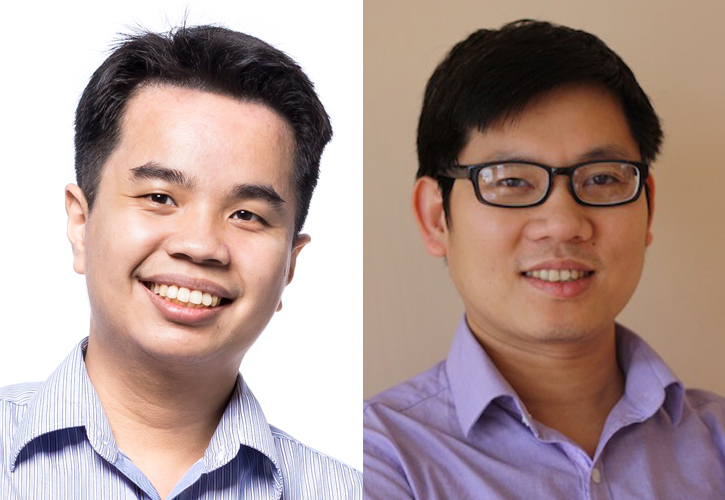College of Arts and Sciences Newsroom

National Science Foundation awards University of Dayton computer scientists $248K for artificial intelligence system to address traffic issues in Vietnam
By Dave Larsen
The National Science Foundation awarded two University of Dayton computer scientists $248,338 to use artificial intelligence to monitor motor vehicle traffic in Ho Chi Minh City, Vietnam, and develop a simulation to help urban planners address traffic and infrastructure problems in the city of more than 8.9 million people.
Tam Nguyen and Phu Phung, assistant professors in the UD Department of Computer Science, will use data from Ho Chi Minh City’s network of 10,000 traffic cameras for real-time analysis of traffic flow, congestion and accidents. The process — known as visual crowd-AI sensing — will provide city planners with actual data for simulating infrastructure changes, such as adding a new bridge or changing the direction of a traffic lane, to determine their potential impacts.
“Normally, for simulations we have to create some dummy data. For this project, we can retrieve exact data,” said Nguyen, the project’s principal investigator, whose research focus is computer vision and machine learning. “We analyze the data by using AI — artificial intelligence — and then we know exactly what traffic will do.”
The two-year grant from the National Science Foundation’s (NSF) Computer and Network Systems division, in collaboration with the U.S. State Department’s Bureau of East Asia and Pacific Affairs, is intended to advance smart and connected communities within the Association of Southeast Asian Nations region.
The grant runs through July 2022 and includes a $36,000 subaward to Nguyen and Phung’s research collaborators at Vietnam National University in Ho Chi Minh City, including Minh-Triet Tran from the University of Science, and Duy-Dinh Le and Khang Nguyen from the University of Information Technology.
“I am pleased to see Dr. Nguyen and Dr. Phung’s work has been recognized by the NSF,” said Mehdi Zargham, professor and computer science department chair. “Their work on this international project will bring recognition to our unit and also create more opportunities for our students.”
Formerly known as Saigon, Ho Chi Minh City is well-known for its traffic congestion and high density of vehicles, with nearly as many motorbikes — 7.5 million — as residents. Motorists tend to travel fast, cross at red lights and ride their motorbikes on sidewalks to circumvent traffic on city streets.
“If you find an empty space, you just ride your vehicle there,” said Nguyen, a Ho Chi Minh City native. “Motorcycles weave through traffic like in the movies.”
The research partners in Vietnam provided one month’s worth of data from about 100 traffic cameras in the city’s center, which Nguyen and Phung are using to train and evaluate their AI algorithms in University of Dayton computer labs. Their challenges include training the state-of-the-art AI model to detect vehicles at night and during Vietnam’s rainy season, which creates camera noise and distortion. After testing their model’s accuracy for tracking vehicles and traffic flow, they will scale up the project to include data from all 10,000 cameras across the 796-square-mile city.
Phung, co-principal investigator and also a Vietnam native, has expertise in cyber security and the Internet of Things (IoT), which allows interrelated, internet-connected objects to collect and transfer data over a wireless network without human intervention. He will help develop a framework that can stream data from IoT devices such as cameras and sensors for the AI component.
“We will adopt cutting-edge cloud technologies for handling large-scale and high-volume real-time traffic from our pluggable client-side framework,” Phung said. “We anticipate that the IoT pluggable framework developed from this project can be used for future, similar crowd-sourcing applications for the common good.”
In addition to creating simulations for city planners, the National Science Foundation wants the team to focus on real-time traffic analysis, which will allow workers monitoring city traffic cameras to quickly spot and resolve problems.
“You have 10,000 cameras and at least 1,000 people looking at the cameras all the time,” Nguyen said. “That’s not very efficient. If you have AI, it can tell you, ‘Hey, there’s a traffic jam over there’ or ‘There’s an accident over here,’ for example. It can help save on labor costs and frees them up to address issues.”
Once perfected, the technology could potentially be applied to any urban area with traffic issues, including U.S. cities such as Los Angeles, Seattle or Atlanta.
“If we can get access to the traffic cameras, then we can apply the same system,” Nguyen said. “We can analyze the congestion, traffic jams and accidents, or we can use it for simulations for city planning.”
For more information, visit the UD Department of Computer Science website.
Shown above (l and r): Tam Nguyen and Phu Phung.
